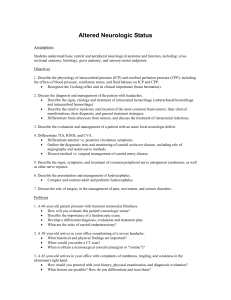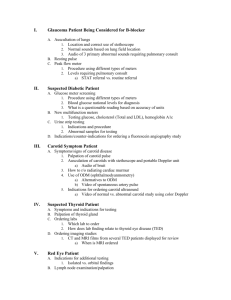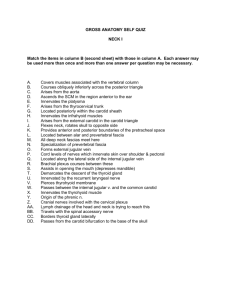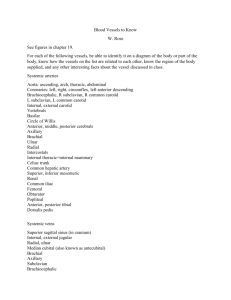Clinical head and neck
advertisement
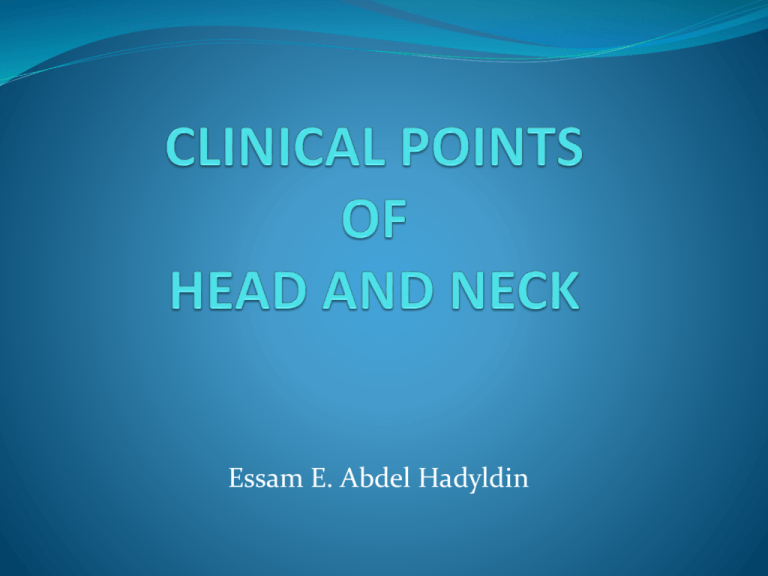
Essam E. Abdel Hadyldin Scalp Layers of the scalp; Skin, connective tissue aponeurosis (epicranial), loose areolar tissue, Pericraniaum. Laceration; Even small, it causes sever blood loss, often difficult to stop Local pressure is the only satisfactory masseur method to stop bleeding. ……………………………...(why) Deep sutures is mandatory ……………………………...(why) In automobile accidents it is common for large lacerated area of the scalp which is attached (hanged) by narrow pedicle, suturing is not followed by necrosis. Wounds caused by blunt objects closely resembles the incised wound Life threatening scalp hemorrhage; encircle the head just above the ears and eyebrows with a tie (tourniquet)………….. (why) Sensory innervation of the face Trigeminal nerve and its three divisions; Ophthalmic Maxillary Mandibular . Great auricular nerve (C2 & C3) Trigeminal Neuralgia It is a common clinical condition. The patient is usually a middle age female, suffers from sever facial pain in the area of distribution of the mandibular and maxillary division of the trigeminal nerve, (the ophthalmic division usually escape). Pain-free interval may last for minutes to weeks. The etiological factor; microvascular affection No abnormal signs on physical examination Motor supply of the face Facial nerve; Damage to the facial nerve in the internal acustic meatus or the parotid gland by tumor or in the facial nerve canal ( perineuritis) (Bell’s palsy) facial muscles paralysis; distortion of the face, drooping of the lower eye lid and the angle of the mouth will sage on the affected side This is lower motor neuron lesion Upper motor neuron lesion (pyramidal) will leave the upper part of the face normal (bilateral corticobulbar fibers) Blood supply of the face Arterial supply; Facial artery Superficial temporaal Transverce facial. Supraorbital Supratrochlear. Tacking the patient’s pulse; by anesthetist The superficial temporal artery as it crosses the zygomatic arch anterior to the ear The facial artery as it winds around the lower margin of the mandible anterior to masseter muscle. It is rare for skin flaps to necroses follow plastic surgery Venous drainage; Dangerous area of the face; bounded by the upper lip, nose and eyes. Boil in this region can cause thrombosis of the facial vein, spread of organism through the inferior ophthalmic vein to the cavernous sinus; cavernous sinus thrombosis. Temporomandibular joint (TMJ) Dislocation; sometime occurs when the mandible is depressed; the joint is unstable so minor injury or just yawing will pull the disc forward beyond the summit , the head of the mandible lies in front of the articular tubercle Reduction is by pressing the a gloved thumbs down on the lower molar teeth (to overcome the tension of temporalis and masseter)and push the jaw backward (to overcome the spasm of lateral ptrygoid). salivary gland Parotid Malignant tumor involving the facial nerve leads to unilateral facial paralysis. Painful parotitis, infection of the parotid gland trough the parotid duct or via blood stream. The pain experienced is due to the limitation of the swollen gland by the parotid fascia (part of the investing deep fascia) Swelling of the Submandibuar salivary gland and enlargement of the Submandibuar lymph nodes my be confused Meticulous search for infection in the area drained by Submandibuar lymph nodes; scalp. Face , maxillary sinus and mouth cavity especially acute infection of the tooth Lingual nerve injury As it passes from the infratemporal to the submandibular fossa, in close relation the last lower molar tooth, it is labile to be damaged in difficult extraction of an impacted third molar tooth. Spontaneous complete recovery from the altered sensation occurs within 8 weeks in 85% to 94% of cases. Skull fractures The anterior cranial fossa; is manifested by epistaxis and cerebrospinal rhinorrhea. The middle cranial fossa; fracture is common due to numerous foramina, cavities and air sinuses, it is manifested by leakage of blood and CSF from the external auditory meatus . The posterior cranial fossa; fracture is manifested by escape of blood into nape of neck , later it appears in the posterior triangle Facial bones fractures Car accidents, boxing and fall are the common causes of facial fractures. Signs of fractures include deformity, ocular deformity, abnormal movements accompanied by crepitation, and malocclusion of teeth. The most common fractures are nasal bones, zygomatic bone and mandible. Maxillofacial fractures occur as a massive facial trauma Intracranial hemorrhage Extradural hemorrhage; Subdural hemorrhage; Subarachnoid hemorrhage; Cerebral hemorrhage Extradural hemorrhage Injury of the meningeal arteries or veins anterior division of the middle meningeal artery Increase of the intracranial pressure with pressure on the motor area in the precentral gyrus subdural hemorrhage Subdural hemorrhage due to tearing of the superior cerebral veins at points of entrance to the superior sagittal sinus as a result of blow or bran displacement within the skull Blood is accumulated between the dura and archnoid Blood clot is removed through burr holes in the skull Subarchnoid hemorrhage Subarchnoid hemorrhage; due to leakage of aneurysm on the circle of Willis. It is diagnosed by withdrawing heavily blood stained cerebrospinal fluid through lumber puncture. Cerebral hemorrhage Cerebral hemorrhage due to rupture of lenticulostriate artery branch of middle meningeal artery It involves vital fibers of corticospinal and corticobulbar in the internal capsule Leads to loss of consciousness, paralysis is evident when consciousness is regained. Platysma Thin sheet of muscle extends between body the mandible downwards over the clavicle onto the anterior chest wall Innervated by cervical branch of facial never Platysma Tone and neck incisions; Laceration and surgical incision must be carefully sutured since the tone of platysma can pull the scar tissue resulted in broad unsighted scar Internal jugular vein Internal jugular vein It begins at the jugular foramen as continuation of the sigmoid sinus draining brain face and neck. It descends in the carotid sheath It unites with the subclavian vein behind medial end of the clavicle to form the brachiocephalic vein. It has two dilatations; superior and inferior bulbs and bicuspid valve directly above the inferior bulb Catheterization It descends from a point halfway between the tip of mastoid process and angle of the jaw, to the sternoclavicular joint, Just above the sternoclavicular joint, it lies beneath skin depression , between the sternal and clavicular heads of sternocleiodomastoid muscle Posterior approach; Two fingerbreadth above the clavicle at posterior border of the sternocleiodomastoid muscle. Anterior approach; At the apex of triangle formed by clavicle and the two heads of sternocleiodomastoid muscle. External jugular vein Begins behind angle of the mandible by union of posterior auricular and posterior division of retromandibular veins. Descends obliquely across the sternomastoiud muscle Just above the clavicle it drains into the subclavian vein. Subclavian v External jugular vein Because of the right side is in a most direct line with the superior vena cava it is the most common used for catheterization It is catheterized halfway between the level of cricoid cartilage and the clavicle. During inspiration when the valves are open Subclavian vein It is a continuation of the axillary vein at the outer border of the 1st rib. It lies below and in front of the 3rd part of subclavian artery behind the clavicle on upper surface of the 1st rib. At the medial border of scalenus anterior it joins the internal jugular vein to form the brachiocephalic vein. Catheterization It lies immediately posterior to the medial third of the clavicle. It is more medially placed on the left than the right side The needle is inserted just below the lower border of the clavicle at junction of medial third and outer two thirds. It is pointed upward and posteriorly towards the middle of the suprasternal notch. Deep fascia Consists of areolar type of connective tissue supporting the muscle, vessel, and viscera of the neck. In certain areas, it forms well defined fibrous sheets; Investing layer. Pretracheal layer. Prevertebral. It is condensed around vessels to form well defined fibrous sheets; Axillary sheath. Carotid sheath. Deep Cervical Fascia Deep fascia and fascial spaces Between the dense layers of deep fascia is loose connective tissue form potential spaces visceral retropharyngeal submandibular and masticatory Organisms from the mouth pharynx esophagus or teeth can spread among the facial planes and spaces Reaching up to the superior mediastinum Sternocleidomastoid muscle Strong thick muscle crosses the side of the neck protects the underlying sot structures from blunt trauma Strangulation Suicide attempts by cutting throat often fails The cervical portions of the common carotids resemble each other so closely that one description will apply to both Each vessel passes obliquely upward, from behind the sternoclavicular articulation, to the level of the upper border of the thyroid cartilage, where it divides into the external and internal carotid arteries. Common carotid arteries At the upper border of the thyroid cartilage it divides to external and internal carotid arteries. At point of division there is a localized dilatation, the carotid sinus, which serves as reflex pressoreceptor mechanism. The carotid body is a small structure lies posterior to point of bifurcation, it is considered as a chemoreceptor. Common carotid artery Common carotid artery Carotid pulse just beneath the anterior border of sternomastoid at the level of the superior border thyroid cartilage In case of carotid sinus hypersensitivity pressure on one or both carotid can cause excessive slowing of the heart rate brdycardia , fall of blood pressure, cerebral ischemia with fainting TRACHEA • The trachea is a fibromuscular tube • It is attached to the cricoid cartilage at • • • • approximately the 6th cervical vertebra. It is 10 to 13 cm long in the adult. Its wideness 13-16 mm in women and 16-20 mm in men. Its lumen is held open by 16 to 20 horseshoe-shaped cartilaginous rings. The posterior part of the tracheal tube is formed by the membranous part which lies in contact with the anterior esophageal wall. The carina, the tracheal bifurcation into two main bronchi, at the level of lower border of the 4th thoracic, in deep inspiration it descends to the level of the 6th thoracic vertebra. It has an angle of 55° open inferiorly. The right main bronchus lies at an angle of about 17° to the midline and the left bronchus at an angle of about 35°. Prof. Saeed Makarem TRACHEOSTOMY Tracheotomy • Operative procedure that creates an artificial opening in the trachea. Tracheostomy • Creation of permanent or semi permanent opening in trachea. TRACHEOSTOMY Indications Upper Airway Obstruction. Pulmonary Ventilation, Toilet. Elective Procedure procedure Meticulous attention to anatomic detail has to be observed, because of the presence of ; Major vascular structures (carotid arteries and internal jugular vein). Thyroid gland. Nerves (recurrent laryngeal branch of vagus and vagus nerve). Pleural cavities, and the esophagus. A vertical tracheal incision is made, and the tracheostomy tube is inserted. Complications of Tracheostomy Hemorrhage: The anterior jugular veins located in the superficial fascia close to the midline should be avoided. If the isthmus of the thyroid gland is transected, secure the anastomosing branches of the superior and inferior thyroid arteries that cross the midline on the isthmus. Nerve paralysis: The recurrent laryngeal nerves may be damaged as they ascend the neck in the groove between the trachea and the esophagus. Pneumothorax: The cervical dome of the pleura may be pierced. This is especially common in children because of the high level of the pleura in the neck. Esophageal injury: Damage to the esophagus, which is located immediately posterior to the trachea, occurs most commonly in infants; it follows penetration of the small-diameter trachea by the point of the scalpel blade. Tracheal stenosis: Larynx Specialized organ that provides a protective sphincter at inlet of air passage and is responsible for voice production Position of larynx : it lies in front of laryngeopharynx. opposite C3-C6 vertebrae. superiorly : it is continuous with laryngeopharynx. inferiorly : it is continuous with trachea. Structure of larynx -it: consists of 9 cartilages connected together by ligaments & membranes and moved by muscles. -it is lined with M.M. Thyroid, cricoid & base of arytenoid cartilages are hyaline cartilages (ossified), / but epiglottis, coriculate, apex of arytenoid and its vocal process & cuneiform are elastic fibrocartilages. IMPORTANT ANATOMICAL AXES FOR ENDOTRACHEAL INTUBATION The upper airway has three axes that have to be brought into alignment if the glottis is to be viewed adequately through a laryngoscope; The axis of the mouth, The axis of the pharynx, The axis of the trachea. IMPORTANT ANATOMICAL AXES FOR ENDOTRACHEAL INTUBATION The following procedures are necessary: First the head is extended at the atlanto-occipital joints. This brings the axis of the mouth into the correct position. Then the neck is flexed at cervical vertebrae C4 to C7 by elevating the back of the head off the table, often with the help of a pillow. This brings the axes of the pharynx and the trachea in line with the axis of the mouth. Complications of Intubation Hypoxemia Aspiration Bronchospasm Trauma (teeth, vocal cords, airway) Thank you
